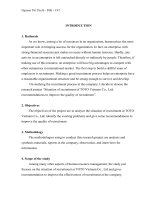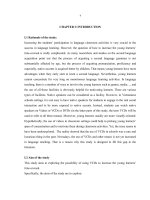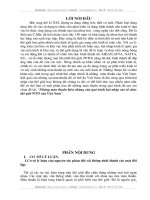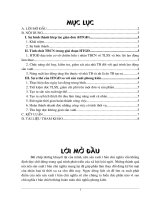No time to train the surgeons
Bạn đang xem bản rút gọn của tài liệu. Xem và tải ngay bản đầy đủ của tài liệu tại đây (53.78 KB, 2 trang )
Editorials
A system that generates more claims, and therefore
an increased burden on clinicians and managers, is not
necessarily a bad system. If the financial responsibility
for claims changes the behaviour of providers and
makes hospitals safer places for patients, then the overall impact may be a reduction of costs, in the wider
sense that includes social harm. Of course, not all
adverse events can or should be prevented: medical
care has inherent risks, resources are limited, and principles of cost effectiveness should apply here as
elsewhere in the NHS. Unfortunately, most NHS
hospitals are some distance from having in place comprehensive cost effective mechanisms to increase
patients’ safety.
“Making Amends” implies two ways in which claims
may be encouraged. Firstly, the proposed basic redress
scheme will make claiming cheaper and quicker, and
more adverse events may consequently result in a
claim. Secondly, eligibility for the proposed redress
scheme for birth related injuries will be based on a test
of causation, not fault, and this should result in more
claims being met than at present. Providing that
healthcare providers see these claims as generating
valuable information and use this as a basis for action
to improve patient safety, increased claims will have
benefits as well as costs. But two conditions must be
met for this to be plausible: the administrative costs of
processing claims must be well controlled and some
financial responsibility for claims should remain with
the healthcare provider. Concerning the first condition, the chief medical officer envisages a streamlined
process for dealing with claims under the redress
schemes. Concerning the second condition, however,
financing the redress schemes has been left open. The
NHS litigation authority has been given the central
responsibility for collecting contributions from NHS
trusts. Whether and how these contributions will be
related to the trusts’ experience in reducing patient
claims remains unclear. This raises complex issues
about the relative complexity of trusts’ case mix, and
the range of variation in contributions that is desirable,
but these issues should be part of the debate about
principles, not just about implementation. Surely a fair
principle is that hospitals with a poor record in
patients’ safety (relative to what might be expected)
should bear a greater share of the compensation costs,
by comparison with hospitals that have a good safety
record. The challenge for the future is to find ways of
harnessing data from the proposed redress schemes to
achieve this end.
Paul Fenn professor of insurance studies
Nottingham University Business School, Nottingham NG8 1BB
()
Alastair Gray professor of health economics and director
Health Economics Research Centre, Department of Public Health,
University of Oxford, Oxford OX3 7LF
Neil Rickman reader in economics
Department of Economics, University of Surrey, Guildford, Surrey
GU2 7XH
Adrian Towse director
Office of Health Economics, London SW1 2DY
Competing interests: None declared.
1
2
3
Department of Health, UK. Making Amends: a consultation paper setting
out proposals for reforming the approach to clinical negligence in the
NHS. DoH: London, 2003.
Capstick JB. Making amends—the future for clinical negligence litigation
[commentary by Leigh B]. BMJ 2004:328:457-60.
Towse A, Fenn P, Gray A, Rickman N, Salinas R. Reducing harm to patients
in the National Health Service. Will the government’s compensation proposals
help? London: Office of Health Economics, 2003.
No time to train the surgeons
More and more reforms result in less and less time for training
S
urgical training in the United Kingdom is beset
by fundamental problems raising what has been
described as “considerable disquiet amongst
trainees and trainers.”1 Basic and higher surgical trainees progress through a system comprehensively
reformed five years ago to emphasise structured training, supervision, and regular assessment. So why are
senior house officers’ skill levels regarded by trainees
and trainers as “very shallow”?2 Why is there
insufficient capacity in the system to train surgeons in
the way that their trainers want?3 And why is it that, in
a recent poll of consultant surgeons, two thirds would
not wish to be operated on by a Calman trained consultant colleague?4
In 1993 Sir Kenneth Calman proposed reforms of
the registrar grades to bring the United Kingdom into
line with a European Union directive on medical training. It was hoped that encouraging structured learning
and supervision would compensate for reducing training time. The European Working Time Directive
became part of British law in 1998, and it means that
418
soon no doctor may work more than 48 hours a week.
The combined impact of these two reforms on surgical
training is profound.
Before Calmanisation and the European Working
Time Directive a trainee could expect to work over
30 000 hours between becoming a senior house officer
and getting a consultant post. The Royal College of
Surgeons calculates that this will now fall to 8000
hours.5 The chief medical officer proposes reforms that
would further reduce this to 6000 hours.6 To become a
competent surgeon in one fifth of the time once
needed either requires genius, intensive practice, or
lower standards. We are not geniuses. So has there
been an increase in the intensity of teaching to
compensate for the fivefold decrease in the length of
surgical training?
Well no, not really. The largest ever survey of senior house officers in orthopaedic surgery showed that
a third of these trainees were not taught in theatre or
clinic.7 That many senior house officers arrive at posts
halfway through their rotations without any real comBMJ VOLUME 328
BMJ 2004;328:418–9
21 FEBRUARY 2004
bmj.com
Editorials
petence in operative skills as basic as suturing and
tying knots is therefore unsurprising. This alone
makes it difficult for them to progress to performing
operations like appendicectomies, which most current
registrars were doing as pre-registration house
officers. The fact that house officers compete with registrars for training time makes this transition impossible for some.
Those surgeons who successfully negotiate the
bottleneck between basic and higher surgical training
posts find that their training needs are often incompatible with a system geared increasingly to provide service.
When registrars need more time than consultants to
perform procedures3; when consultants’ results are
audited irrespective of who performed the operation;
when trusts’ stars and status depend on output and outcome, where is the incentive to train? And where are the
resources? One regional survey indicated that, even with
trainees performing every operation, the total number
of procedures available was a third less than the
minimum recommended by their trainers.3 The increase
in theatre time required for increased trainee operating
in one specialty was estimated at 270 extra theatre days
per year, at a cost to the region of £1.3m.3
Reform after reform of the NHS has been driven
and informed by factors frequently very far away from
the realities of providing surgical patients with
continuity of care and of training the next generation
of surgeons. Those of us lucky enough to be under way
with our training on good teaching rotations can only
feel relief that we are not in the cohort coming behind.
We cannot rely on highly able and motivated
trainees and trainers to struggle on like this. Surgical
training must be recognised as a priority, and it must be
resourced with the time and funding, not only for skills
courses and wet labs (where surgeons can practise
techniques on appropriate models), but also for
dedicated training lists and clinics, just as happened for
waiting list initiatives.1 5 7 Not all consultants should be
obliged to train all trainees1 8; those consultants that do
choose to undertake the additional responsibility and
workload of training should be better supported.1 3 5 8
Why should they not also be rewarded? Senior trainees
should benefit from a substantial period of supervised
independent operating similar to the old senior regis-
trar grade,1 and assessment needs to be competency
based, not dependent on a fixed time period in the
grade.5 8
Most current trainees are supposed to become the
new “generalist” surgeons who will carry out common
procedures, referring more complex patients on to
“specialist” consultant colleagues.9 We are left in the
worrying situation where 6000 hours of surgical training in its current state may not be enough to produce
these new generalists, let alone provide consultants
that can go on to become the kind of specialist consultant surgeon that we take for granted today.
Joanna Chikwe specialist registrar
()
Anthony C de Souza programme director
()
John R Pepper chairman of London Deanery
Cardiothoracic Speciality Training Committee
()
Cardiothoracic Surgery, Royal Brompton Hospital, London SW3 6NP
Competing interests: None declared.
1
2
3
4
5
6
7
8
9
Murday A, Hamilton L, Magee P, Hyde J. The conflict between service and
training in cardiothoracic surgery: a report of a short-life working group of the
Society of Cardiothoracic Surgeons of Great Britain and Ireland. London:
Society of Cardiothoracic Surgeons of Great Britain and Northern
Ireland, 2000.
De Cossart L, Wiltshire C, Brown J. An audit of the operative skills of
SHOs on BST programmes. Ann R Coll Surg Eng 2001;83(suppl):S326-7.
Crofts TJ, Griffiths JM, Sharma S, Wygrala J, Aitkin RJ. Surgical training:
an objective assessment of recent changes for a single health board. BMJ
1997;314:814.
Morris Stiff GJ, Clarke D, Torkington J, Bowrey DJ, Mansel RE. Taining in
the Calman era: what consultants say. Ann R Coll Surg Engl
2002;84(suppl):345-7.
Phillip H, Fleet Z, Bowman K. The European Working Time Directive—
interim report and guidance from The Royal College of Surgeons of England
Working Party. London: Royal College of Surgeons, January 2003.
Donaldson L. Unfinished business: proposals for reform of the senior house
officer grade. NHS consultation paper. London: Department of Health,
August 2002.
British Orthopaedic Association. Education and training for SHOs: a snapshot of the moment and recommendations for the future. London: British
Orthopaedic Association, July 2002.
Liaison Group of the Specialist Training Authority, Joint Committee of
Postgraduate Training for General Practice and the General Medical
Council. Policy statement. Taking stock: the challenges facing medical training and
education within a changing NHS. London: Specialist Training Authority,
December 2002.
Department of Health. Modernising medical careers: the response of the four
UK health ministers to the consultation on unfinished business. London: DoH,
February 2003.
Prognosis after cochlear implantation
Children benefit the most as do many adults
M
BMJ 2004;328:419–20
BMJ VOLUME 328
ultichannel cochlear implant systems were
approved by the Food and Drug Administration for adults in 1985 and for children in
1990. NHS funding became available in the early
1990s. About 4000 patients have received implants in
the United Kingdom (50 000 worldwide). Children
now outnumber adults by 2:1. Cochlear implants are
reliable, and cochlear implant surgery is safe despite
recent concerns regarding a risk of meningitis. The
numbers of suitable candidates is rising as selection
criteria change, and it is timely to consider the benefits
and risks of the technique.
21 FEBRUARY 2004
bmj.com
A cochlear implant takes the place of the damaged
organ of Corti and stimulates the spiral ganglion cells
directly. Acquired causes of hair cell loss include infection such as rubella, cytomegalovirus infection,
mumps, measles, meningitis, and middle ear infection,
drug toxicity, trauma, and autoimmune disease, as well
as Menière’s disease and cochlear otosclerosis.
Congenital hair cell loss may be due to recessive
inheritance or may be the result of failure of
normal intrauterine development of the inner ear due
to causes of which some are known, some as yet
unidentified.
419









